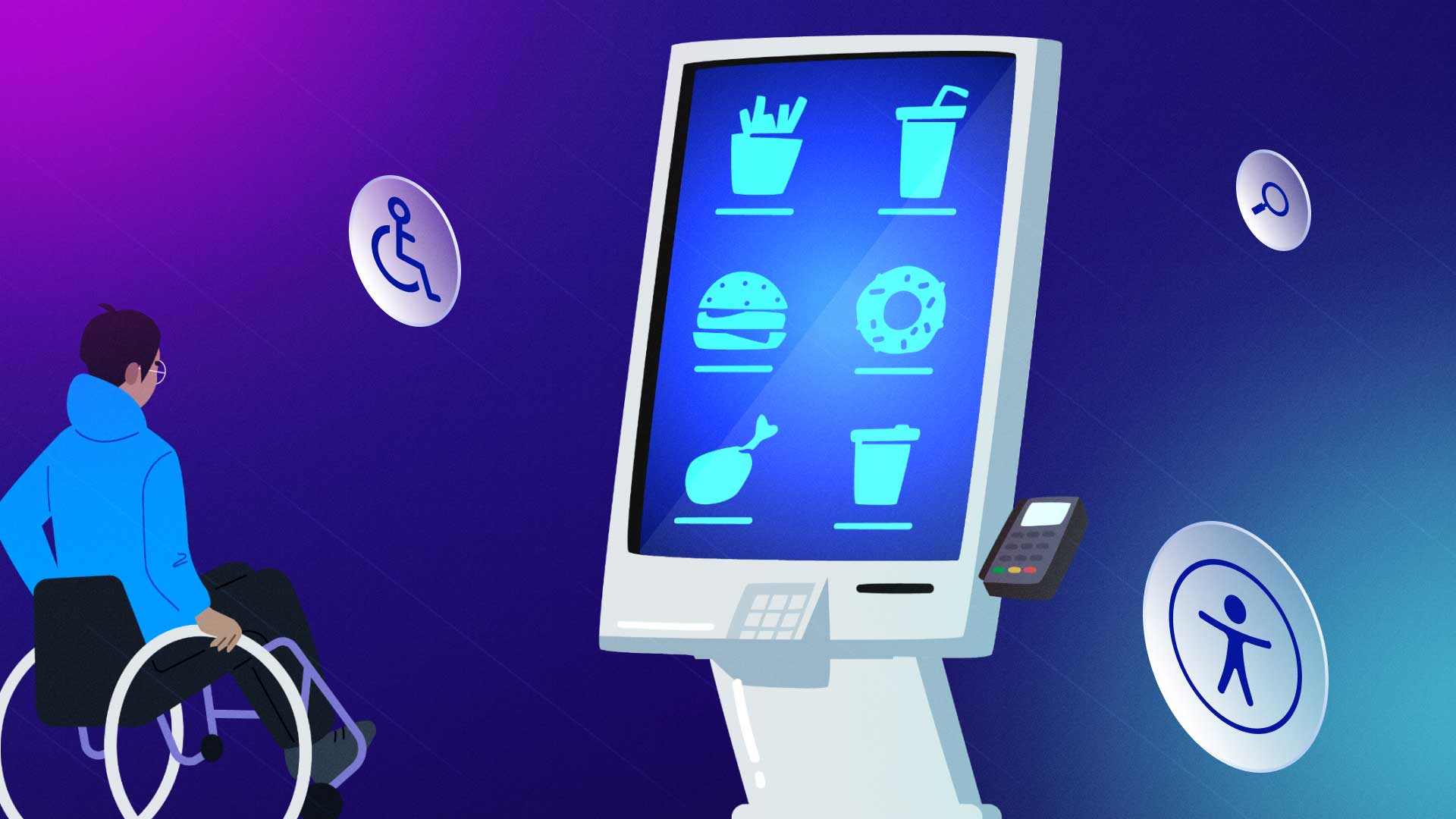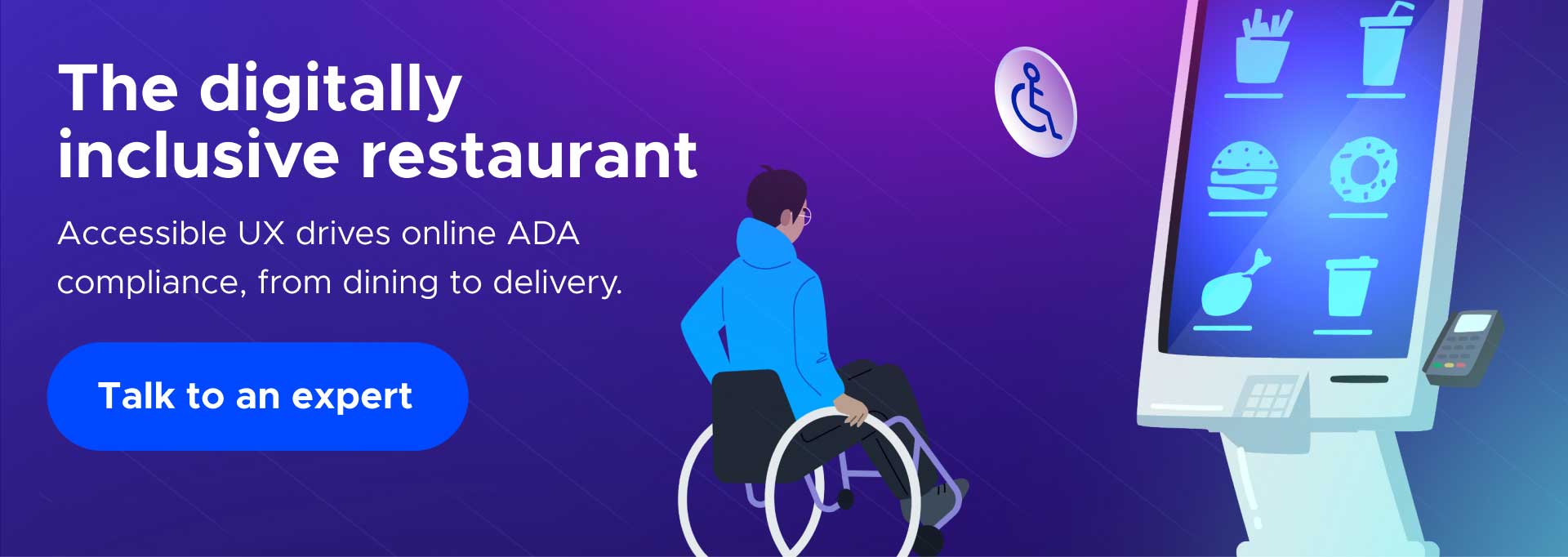ADA Requirements for Restaurants: Digital Inclusion, From Dining to Delivery

Since the onset of the pandemic, the restaurant industry is one of many sectors that saw an increase in digital experiences and online consumerism. From fast-food to fine dining establishments, online inquiries, reservations and ordering became a critical means to drive revenue and survive in an unstable global economy. Some consumers readily jumped at the chance to dine out when dining establishments reopened, assured that compliance with everything from ADA requirements for restaurants to new public health regulations would lower risk of infection and provide a safe and accessible on-site dining experience.
Others preferred to err on the side of caution, and adopted online and digital meal services for delivery, takeout, or curbside pick-up as a part of their daily lives.
Meal delivery services in the U.S. grew by 85% from January 2018 to February 2020. And February to December 2020 delivery numbers grew by a whopping 96%, as more food vendors adopted digital solutions to meet delivery demands and battle through the global economic crisis. 2021 brought $39.1 billion dollars of venture capital investments to the food tech industry, with over 50% of funding dedicated to applications like marketplaces and applications for restaurants and food delivery services.
Recent research tells us that online food delivery revenue in the United States is forecasted to reach $1 trillion in 2023. And as an industry, the online food delivery market is expected to reach $165 billion by 2029. Another source tells us that people who place orders online are more likely to use a restaurant’s website over a third-party app, and 35% of consumers are influenced by online reviews of restaurants.
These insights clearly underpin the importance of digitally accessible consumer experiences in the restaurant industry, from websites, to apps, and ordering systems.
Established in 1990 to ensure that individuals of all abilities can be accommodated in public places of business, the ADA extends to digital commerce on websites and mobile apps, restaurants included. Dining establishments that integrate online ordering, reservation booking, or use digital experiences in a range of online environments to support online presence and brand should conform to digital accessibility compliance laws and follow WCAG guidelines.
In this blog post we examine 8 digital accessibility tips to help meet ADA requirements for restaurants that are integral to providing inclusive online user experiences in an industry making headways through digital consumerism.
For detailed insight on the physical and spatial regulations of businesses open to the public like food vendors or dining establishments, reference the ADA requirements for restaurants directly.
8 Tips for Digitally Accessible Restaurant Industry Experiences
Maintaining an accessible restaurant means that inclusive online and digital experiences support ADA compliance of dining establishments. From websites driving strong online presence and generating brand awareness, to integrating an accessible restaurant ordering system for meal delivery and pick-up, digital experiences and inclusion starts with adopting best practices. We’ve compiled a list of 8 tips to support digitally inclusive experiences for the ADA compliant restaurant in an industry and business world of ongoing technological advancements.
1. Image Alt Text for Digitally Accessible Restaurant Orders
Only looking into someone else’s plate can make your mouth water more than seeing a picture of scrumptiously tasty treats on a restaurant’s website. Research shows that 70% of people react to pictures of food as if it were sitting right in front of them. So if your website has images of menu items, your restaurant is increasing the chances of someone being hungrily compelled to make a reservation, pop in spontaneously, or order delivery or takeout.
Now imagine someone with vision or cognitive disabilities who depends on a screen reader to interact with a restaurant’s website or online menu. Since they can’t see the image of your restaurant’s delectable dish, screen readers will scan the website or digital menu for image alt text, a succinct and accurate description of visuals. Written well to include descriptive details like preparation, cooking or baking, ingredients and flavors this food appeals to, and appearance, image alt text of food on your website can be a strong factor for higher conversion rates.
Anyone engaging with your accessible restaurant website’s image alt text using screen readers or braille displays could be more easily and quickly convinced to make a reservation and enjoy a meal at your dining establishment. Well-written image alt text can also give diners a good sense of the tastes to experience from your menu items, potentially driving the urge to satisfy a craving or satiate a hungry and growling stomach.
Image alt text also increases a website’s chances of showing up earlier in a search engine results page (SERP). So if the image alt text reads, “a juicy hamburger on a sesame bun with fresh veggies and secret sauce,” someone searching for any of these words online could land on your ADA compliant restaurant website sooner than a competitor’s. Your website is maximizing the possibilities to create a satisfying win-win scenario. With image alt text, the accessible restaurant delivers inclusive online experiences and engagements that sell, while customers can order online or in-person with their taste buds knowing what to expect.
2. Appropriate Headings for Ease of Navigation & More Sales
Everyone wants a simple and seamless online ordering experience, especially someone who’s hungry and just wants their food to be ready for delivery or pick-up quickly. Screen readers and braille displays are commonly used assistive technologies that scan website structure and headings to help users with various vision, motoric, or cognitive abilities navigate a website. Creating accurate and appropriate headings that are easy to understand could be paramount for digital experiences like skimming an online menu or placing an order.
3. Transcripts for Audio & Video Content: Envision Dining in Words
People with hearing or visual disabilities may not be able to engage with audio and video content the conventional way, but transcripts can be game-changing for digital inclusion. Testimonials and customer experience videos play a weighty role in influencing opinions and impressions of online consumers, and the restaurant industry is no exception. Potential diners using assistive technology like screen readers, braille displays and keyboard navigation can engage with video or audio content about first-hand experiences with a restaurant’s food, services, staff, and environment.
4. Digitally Inclusive PDFs for the ADA Compliant Restaurant Online
Some dining establishments will integrate PDF files on their website like menus, or a breakdown of services and pricing for catering, on-site chefs or cooking workshops, or various events hosted at the venue or off-site. Dining establishments looking to position themselves as leaders in digital innovation should ensure PDFs conform to ADA requirements and WCAG web accessibility guidelines.
Some assistive technologies scan PDFs to relay information to people with disabilities. Adhering to digital accessibility guidelines for PDF documents extends inclusion and extends revenue potential. Using an AI-powered Accessible PDF creator can identify violations and automate remediation or fixes, helping dining establishments conform to digital accessibility compliance laws.
A word to the wise and general best practice: creating a text-based menu for accessible restaurant ordering online is a more digitally inclusive practice, since screen readers or braille displays can scan and relay text to diners with ease. The added bonus: Google crawlers will index the menu content when it’s text-based, extending reach to potential diners with this SEO strategic best practice.
5. HTML Labels for Form Fields Create Seamless UX with Assistive Tech
Online forms for dining establishments are used to make inquiries, book reservations, place an order for delivery, takeout, and support various processes and transactions like purchasing or redeeming gift cards.
Correctly coded HTML labels help screen readers align with user interface (UI) elements to ensure that filling out forms on websites, platforms, or applications is a simple and seamless process for users of various abilities. Correctly coded HTML labels and intuitive design of UI support uninterrupted keyboard navigation so forms can be accurately and easily completed.
Since users of various abilities rely on assistive technology for digitally inclusive experience, ensuring correct coding of HTML labels can increase sales of the online ADA compliant restaurant, while strengthening online presence and brand visibility.
6. Descriptive Buttons & Hyperlinks: Place My Order Now Vs Submit
Most times hungry website visitors or app users of dining establishments aren’t the most patient bunch. Their goal is usually to find the right menu item, order it, and have it delivered, or stop by the restaurant to pick it up. Simple, right? Well, it should be. And one way to ensure ADA restaurant compliance of digital experiences is creating simple, straightforward messages for buttons and hyperlinks for online navigation, but especially for ordering systems or forms.
“View online menu options,” or “place my order now” are more effective than ambiguous or indirect messages for buttons or hyperlinks like “submit” or “click here.” Clear messages and content for hyperlinks, buttons, and menu navigation functions enhance UX with easy navigation, supporting digital inclusion. Form submission for inquiries and orders, and transactions become simple processes. Ultimately, the more descriptive and onpoint the text is for buttons and hyperlinks, the more likely UX will be accessible, satisfying, and generate sales.
7. Font Types & Sizes and Sufficient Color Contrast: Visibility & Legibility
We’ve said it before, but most times, patience can run thin for the hungry online user who’s ready to order their next meal. And if their tummies aren’t rumbling yet, but they’re exploring websites for dinner spots with takeout or delivery, poor readability due to font type and size or inadequate color contrast could make potential diners bounce from your digital space. These integral visual elements of digital environments’ UI can be deal breakers for diners with vision impairments, cognitive, or learning disabilities like dyslexia.
Your restaurant might be the talk of the town, but if website, app, or platform content legibility levels are low because of the font type and size, or lack of color contrast of text and background, accessibility and universal usability of digital experiences are at risk. You could be discouraging potential customers from fully considering your dining establishment with digital experiences that have inclusion issues. Worse yet, you could be tarnishing brand reputation, lose the sale, and be at legal risk by neglecting or overlooking this web accessibility violation.
If your restaurant’s digital experiences present readability issues to users without abilities or impairments, then consider what the experience could be like for users who may be colorblind, have low vision, are recovering from cataract surgery or an accident, or have ADHD. Integrating an AI-powered digital accessibility solution can make adjusting font type and size, color contrast, line spacing and other visual UI elements that are integral to enhanced UX an easy and instantaneous process.
8. Accessibility Statement for The ADA Compliant Restaurant Website
Including a web accessibility statement on your restaurant’s website is a public confirmation of your establishment’s dedication to digital inclusion and ensuring a barrier-free consumer experience. Creating a legit website accessibility statement could mean partnering with either a lawyer or having the right digital accessibility partner write a custom statement that’s in tune with your restaurant’s brand messaging.
UserWay: The Digitally Accessible Restaurant Online, Made Easy
UserWay provides a comprehensive framework of AI-powered digital accessibility solutions and services that support the ADA compliant restaurant for inclusive digital experiences. Supporting online conformance with WCAG web accessibility guidelines ADA regulations, UserWay’s Pro Widget 4.0 enhances UX of your restaurant’s website, app, or platform.
With simple integration, a winning support team, and certified web accessibility expertise, UserWay can help your dining establishment give consumers a taste of truly accessible digital experiences, from eating out, to delivery, takeout, or curbside pick-up.
Connect with a UserWay digital accessibility expert and book your demo today.
Answers to Common FAQs
Are ADA requirements for restaurants relevant for digital and online experiences?
Yes, absolutely. ADA compliance laws are relevant for any business open to the public, including online commercial environments like websites, platforms, or applications. With the onset of the pandemic, the restaurant industry heavily relied on the increasing shift to digitally inclusive experiences to drive revenue and survive the global economic crisis. Accessibility of online reservations, ordering delivery, or takeout, or browsing a dining establishment’s website became a bigger priority to dining establishments.
The increasing demand for digitally accessible online experiences for diners has impacted and continues to influence restaurant industry consumerism. Digital inclusion with accessible online experiences play a critical role in converting hungry online website visitors into satisfied returning restaurant frequenters.
What are some best practices supporting ADA compliant restaurant experiences online?
The WCAG guidelines are considered the golden standard for digital accessibility in any industry, and restaurant websites, applications, and platforms are no exception. Some best practices worth adopting to create digitally inclusive online experiences for dining establishment customers include:
- Creating descriptive and accurate image alt text
- Developing a strategic and logical hierarchy and structure of web pages, or app and platform UI with precise headings and heading formats
- Audio & video transcripts
- Accessible PDF files
- Correctly coded HTML labels of form fields to support assistive technologies
- Descriptive buttons and hyperlinks
- Font types & sizes and sufficient color contrast for optimal readability & visibility
How do I make my restaurant accessible for digital experiences?
Integrating an AI-powered web accessibility solution like UserWay’s Pro Widget 4.0 can help restaurant websites, applications, and platforms provide digitally inclusive online experiences. Supporting enhanced UX, seamless, and simple online reservation booking and ordering, UserWay’s reliable web accessibility tool is trusted by over a million website owners globally, and millions of online users of diverse abilities everywhere.





Share